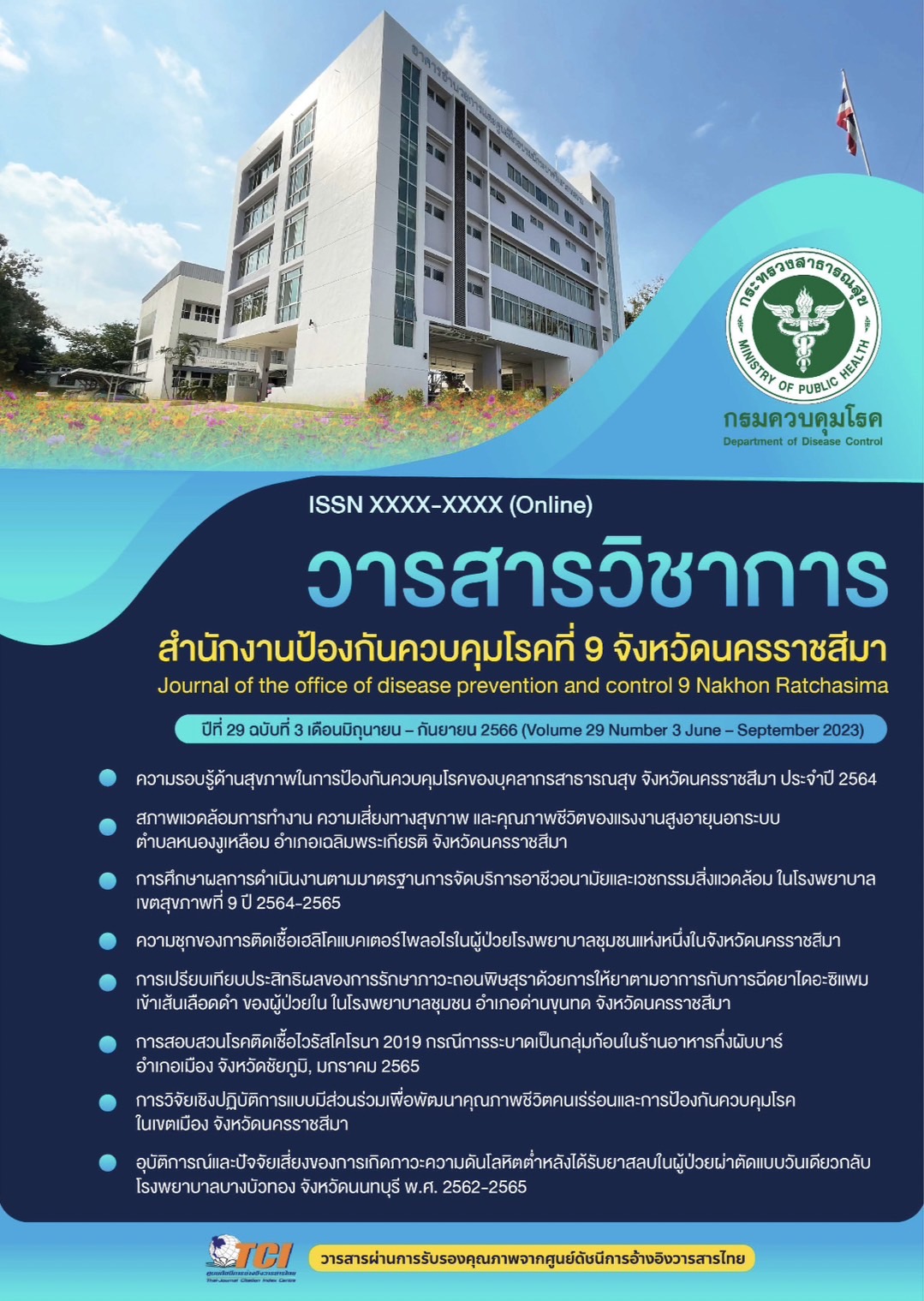Incidence and risk factors of post-anesthetic hypotension among one-day surgery patients, Bangbuathong hospital, Nonthaburi, 2019-2022
Keywords:
Hypotension, Anesthesia, One-day surgeryAbstract
Post-anesthetic hypotension following one-day surgery was investigated within the scope of this study. The primary objective was to examine the incidence and risk factors associated with post-anesthetic hypotension among patients undergoing one-day surgery at Bangbuathong Hospital. Data collection spanned from October 2019 to June 2022. The study also aimed to outline patient characteristics and ascertain correlation coefficients among the factors under investigation. Furthermore, the Chi-square and Fisher exact tests were utilized to assess differences between patient groups that experienced post-anesthetic hypotension and those that did not, focusing on nominal data. Continuous data underwent analysis through the Student T, Rank Sum, and Kruskal Wallis tests. Logistic regression was performed to identify factors influencing post-anesthetic hypotension. The results revealed a post-anesthetic hypotension incidence of 21.10%. Notably, the type of treatment and sex exhibited a strong correlation (correlation coefficient > 0.70) with the incidence rate. Additionally, significant differences were observed in gender, treatment type, sedation method, age, mean preoperative pulse rate, and operation duration between the patient groups (p-value < 0.05). Identified risk factors encompassed advanced age, prolonged operation duration, male gender with a preoperative pulse rate below 70 beats per minute, and deep sedation. Subsequently, after accounting for other variables, male gender and preoperative pulse rate below 70 beats per minute retained their significance as risk factors. In summary, the incidence of post-anesthetic hypotension was determined to be 21.10%, with significant risk factors being male gender, older age, lengthier operation duration, preoperative pulse rate below 70 beats per minute, and deep sedation. Anesthesiologists should exercise heightened vigilance when monitoring hypotension in elderly male patients, particularly those with a low preoperative pulse rate (below 70 beats per minute). This emphasis is especially crucial for patients undergoing extended surgical procedures, receiving deep sedation, and undergoing one-day surgery treatment.
References
Wesselink EM, Kappen TH, Torn HM, Slooter AJ, Van Klei WA. Intraoperative hypotension and the risk of postoperative adverse outcomes: a systematic review. Br. J. Anaesth. 2018;121(4):706-21.
Reich DL, Hossain S, Krol M, Baez B, Patel P, Bernstein A, Bodian CA. Predictors of hypotension after induction of general anesthesia. Anesthesia & Analgesia. 2005;101(3):622-8.
Bijker JB, Van Klei WA, Vergouwe Y, Eleveld DJ, Van Wolfswinkel L, Moons KG, et al. Intraoperative hypotension and 1-year mortality after noncardiac surgery. ASA. 2009;111(6):1217-26.
Loeb RG. A measure of intraoperative attention to monitor displays. Anesthesia & Analgesia. 1993;76(2):337-8.
สุนีย์ ศรีสว่าง, จตุพงษ์ พันธ์วิไล, ศักดิ์ระพี ชัยอินทรีอาจ. อุบัติการณ์การเกิดภาวะแทรกซ้อนทางวิสัญญีโรงพยาบาลประสาทเชียงใหม่ ปีงบประมาณ 2557-2559. วารสารกรมการแพทย์. 2018;43(1):106-11.
Somboonviboon W, Kyokong O, Charuluxananan S, Narasethakamol A. Incidence and risk factors of hypotension and bradycardia after spinal anesthesia for cesarean section. J Med Assoc Thai. 2008;91(2):181-7.
Hartmann B, Junger A, Klasen J, Benson M, Jost A, Banzhaf A, et al. The incidence and risk factors for hypotension after spinal anesthesia induction: an analysis with automated data collection. Anesth Analg. 2002;94(6):1521-9.
Kang AR, Lee J, Jung W, Lee M, Park SY, Woo J, et al. Development of a prediction model for hypotension after induction of anesthesia using machine learning. PLoS One. 2020;15(4):e0231172.
ธัญเดช นิมมานวุฒิพงษ์, ทวี รัตนชูเอก, กิตติวัฒน์ มะโนจันทร์, วิบูลย์ ภัณฑบดีกรณ์. ข้อเสนอแนะด้านการพัฒนาระบบบริการผ่าตัดแบบวันเดียวกลับ (One Day Surgery: ODS) และการผ่าตัดแผลเล็ก (Minimally Invasive Surgery: MIS) ปี 2565. พิมพ์ครั้งที่ 1. กรุงเทพมหานคร: บริษัท จรัลสนิทวงศ์การพิมพ์ จำกัด; 2564.
Weir CB, Jan A. BMI Classification Percentile And Cut Off Points [Internet]. 2022 [cited 2023 Jan 01]. Available from: https://europepmc.org/article/nbk/nbk541070#_article-35288_s5_.
The American Heart Association. Bradycardia, Slow Heart Rate [Internet]. 2022 [cited 2023 Jan 01]. Available from: https://www.heart.org/en/health-topics/arrhythmia/about-arrhythmia/bradycardia--slow-heart-rate.
DeMers D, Wachs D. Mean arterial pressure [Internet]. 2021 [cited 2023 Jan 01]. Available from: https://www.ncbi.nlm.nih.gov/books/NBK538226/.
American Society of Anesthesiologists. ASA Physical Status Classification System [Internet]. 2020 [cited 2023 Jan 01]. Available from: https://www.asahq.org/standards-and-guidelines/asa-physical-status-classification-system.
Südfeld S, Brechnitz S, Wagner JY, Reese PC, Pinnschmidt HO, Reuter DA, et al. Post-induction hypotension and early intraoperative hypotension associated with general anaesthesia. Br J Anaesth. 2017;119(1):57-64.
Jor O, Maca J, Koutna J, Gemrotova M, Vymazal T, Litschmannova M, et al. Hypotension after induction of general anesthesia: occurrence, risk factors, and therapy. A prospective multicentre observational study. J Anesth. 2018;32(5):673-80.
Kouz K, Hoppe P, Briesenick L, Saugel B. Intraoperative hypotension: Pathophysiology, clinical relevance, and therapeutic approaches. Indian J Anaesth. 2020;64(2):90-6.
Cheung CC, Martyn A, Campbell N, Frost S, Gilbert K, Michota F, et al. Predictors of intraoperative hypotension and bradycardia. Am J Med. 2015;128(5):532-8.
Bishop DG, Cairns C, Grobbelaar M, Rodseth RN. Obstetric spinal hypotension: Preoperative risk factors and the development of a preliminary risk score - the PRAM score. S Afr Med J. 2017;107(12):1127-31.
Hafeez Y, Grossman SA. Sinus bradycardia [Internet]. 2021 [cited 2023 May 27]. Available from: https://www.ncbi.nlm.nih.gov/books/NBK493201/
Lee JE, George RB, Habib AS. Spinal-induced hypotension: Incidence, mechanisms, prophylaxis, and management: Summarizing 20 years of research. Best Pract Res Clin Anaesthesiol. 2017;31(1):57-68.
Chen B, Pang QY, An R, Liu HL. A systematic review of risk factors for postinduction hypotension in surgical patients undergoing general anesthesia. Eur Rev Med Pharmacol Sci. 2021;25(22):7044-50.
Liu X, Rabin PL, Yuan Y, Kumar A, Vasallo P, Wong J, et al. Effects of anesthetic and sedative agents on sympathetic nerve activity. Heart Rhythm. 2019;16(12):1875-82.
Sneyd JR, Absalom AR, Barends CRM, Jones JB. Hypotension during propofol sedation for colonoscopy: a retrospective exploratory analysis and meta-analysis. Br J Anaesth. 2022;128(4):610-22.

Downloads
Published
How to Cite
Issue
Section
License
Copyright (c) 2023 The office of disease prevention and control 9th Nakhon Ratchasima

This work is licensed under a Creative Commons Attribution-NonCommercial-NoDerivatives 4.0 International License.
บทความที่ลงพิมพ์ในวารสารวิชาการสำนักงานป้องกันควบคุมโรคที่ 9 จังหวัดนครราชสีมา ถือว่าเป็น
ลิขสิทธิ์ สำนักงานป้องกันควบคุมโรคที่ 9 จังหวัดนครราชสีมา



